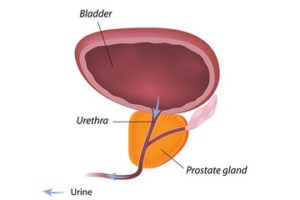
The results of a recent study in the United Kingdom are in line with what a number of researchers (here, here, and here) have been writing about for a while - that studies show that some cancer screening (e.g. for prostate cancer) of people with no symptoms does not save lives.
The UK study randomly assigned men (aged 50 to 69) to get a PSA test one time or to not get a PSA test (the controls). The PSA test measures prostate-specific antigen in the blood, and is typically used to screen for prostate cancer. It is not done routinely in the UK. They found that while more men were diagnosed with prostate cancer in the PSA group, after 10 years there was no statistical difference in death rates between the two groups. As the researchers themselves said, the PSA screening test resulted in "an increase in the detection of low-risk prostate cancer cases" (the ones that wouldn't cause a problem). But not in the aggressive killer cancers. However, the researchers are now continuing the study to see if there are differences in the 2 groups after an even longer period of time. From Medical Xpress:
One-off PSA screening for prostate cancer does not save lives
Inviting men with no symptoms to a one-off PSA test for prostate cancer does not save lives according to results from the largest ever prostate cancer trial conducted over 10 years by Cancer Research UK-funded scientists and published today (Tuesday) in the Journal of the American Medical Association (JAMA). Researchers at the Universities of Bristol and Oxford found that testing asymptomatic men with PSA detects some disease that would be unlikely to cause any harm but also misses some aggressive and lethal prostate cancers.
The CAP Trial, which spanned almost 600 GP practices in the UK and included more than 400,000 men aged 50-69, is the largest trial ever to investigate prostate cancer screening. The trial compared 189,386 men who were invited to have a one-off PSA test with 219,439 men who were not invited for screening. After an average of 10 years follow up, there were 8,054 (4.3%) prostate cancers in the screened group and 7,853 (3.6%) cases in the control group. Crucially, both groups had the same percentage of men dying from prostate cancer (0.29%).
While some prostate cancers are aggressive and lethal, others are clinically insignificant and will never lead to any harm or death if left undetected. Ideally, aggressive prostate cancers need to be identified and treated as early as possible. But finding a cancer that would never have caused men harm during their lifetime can have a serious impact on quality of life, including the worry of a cancer diagnosis, the possibility of infection following a biopsy and impotence and incontinence following treatment. ... Dr Richard Roope, Cancer Research UK's GP expert, said: "The PSA test is a blunt tool missing the subtleties of the disease and causing men harm.

Prostate cancer screening and early detection does NOT save men’s lives. Let’s do the math. Per the USPSTF (U.S. Preventive Services Task Force): “Only one man in 1,000 could possibly have a life saving benefit from screening” and “A small benefit and known harms from prostate cancer screening”. About 1.3 to 3.5 deaths per 1,000 from prostate blind biopsies. Also 5 men in 1000 died and 20.4% had one or more complications within 30 days of a prostatectomy. This does not include deaths, injuries and side effects from radiation and other procedures, medical mistakes, a 5 times higher suicide risk, ADT therapy complications, heart attracts, depression, low quality of life, etc, caused by prostate cancer screening and treatments. Detection and overtreatment of prostate cancer has killed or destroyed millions of men’s lives worldwide from understated and multiple undisclosed side effects. The doctor that invented the PSA test, Dr. Richard Ablin now calls it: “The Great Prostate Mistake”, “Hoax” and “A Profit Driven Public Health Disaster”. Follow the money!
Recommended books:
The Great Prostate Hoax by Richard Ablin MD (the inventor of the PSA test)
The Big Scare, The Business of Prostate Cancer by Anthony Horan MD.
A 12 or 18 core blind biopsy, holey prostate! One million dangerous prostate blind (TRUS) biopsies are performed in the USA each year and they should be banned: Invasive, dangerous, degrading and unnecessary. Men with a high PSA tests result are often sent to an urologist for a blind biopsy. This technology is (obsolete) 30 years old. Would you use a cell phone or drive a car that was designed 30 years ago? You may not own your biopsy samples. Blind prostate biopsy cost in the USA is at least $3 billion annually. False positives and false negatives do occur. Men should be told about other options; Percent free PSA test, 4Kscore test, SelectMDX, PCA3 test or a 3T MRI test before receiving a blind biopsy. These tests can often eliminate the need for a risky and invasive blind biopsy. Unfortunately, sometimes insurance companies may not pay for other tests. Insertion of 12 or 18 large hollow needles through the dirty rectum into a gland the size of a walnut, a blind biopsy can result in pain, infections, a risk of temporary or permanent erectile dysfunction. https://www.youtube.com/watch?v=IRbJPOgIU0k. Biopsies can cause, urinary problems, An infection rate of 7.2%, up to a 6.9% hospitalization rate within 30 days from a complication[11], sometimes even death from sepsis (About 1.3 to 3.5 deaths per 1,000). There is also debate that a biopsy may spread cancer because of needle tracking, no one can give you a 100% honest answer. A blind biopsy is degrading and can also increase PSA reading for several weeks or months, further frightening men into unnecessary treatment. Blind biopsies are almost never performed on other organs.